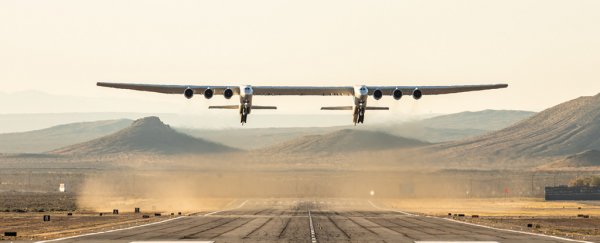Stratolaunch, the massive aircraft dreamed up by the late Paul Allen, flew for the first time on Saturday, becoming the largest plane by wingspan ever to take to the skies.
Larger than Howard Hughes's Spruce Goose - which flew only once, in 1947- Stratolaunch lifted off from the Mojave Air and Space Port in the California desert and stayed aloft for 2.5 hours, company officials said, hitting an altitude of 17,000 feet (5,000 metres) and a maximum speed of 189 mph (304 km/h).
The plane is a behemoth, with a twin fuselage, 28 wheels, six 747 jet engines and a wingspan longer than a football field, end zones included.
"We finally did it," Jean Floyd, Stratolaunch's chief executive, said in a call with reporters. He said it was inspiring "to see Paul Allen's dream come to life."
But Allen, the billionaire co-founder of Microsoft, died in October, leaving the future of the plane and the company behind it in doubt. Company officials did not take questions from reporters and did not address the future of the venture in a news release.
Since Allen's death, the company has dramatically scaled back operations and laid off dozens of employees.
From the beginning, Allen's dream was to use the plane to help make getting satellites, and possibly people, into space more affordable and accessible.
Built by Scaled Composites, a subsidiary of Northrop Grumman, Stratolaunch was designed to carry as many as three rockets tethered to its belly into the skies; the rockets would then drop, ignite and shoot off into space with their payloads.
Allen was fascinated with the capabilities of small satellites, how they could help keep tabs on Earth's environment, and thought "air-launching" rockets, as the process is called, could help usher in a new era of spaceflight.
"The capabilities of these small satellites is something that's really interesting and fascinating," he said. "Both for communications, where a lot of people are putting up constellations of satellites, and for monitoring the challenged health of the planet."
By launching rockets from the belly of a plane, instead of vertically from a launch site, the company hoped to reduce the cost of space missions. It's also the model used by Richard Branson's Virgin Galactic, which has developed a space plane capable of taking people to the edge of space. Virgin Orbit, another Branson-backed venture, is also working to launch rockets from a plane.
The Pentagon, which is looking to become more responsive in space, had also taken an interest in Stratolaunch. Air Force Secretary Heather Wilson visited the plane, as did Vice President Pence, the head of the National Space Council.
The company was even thinking about human spaceflight and had preliminary plans to develop a mini space shuttle called "Black Ice."
But for now all those plans appear to be on hold.
Allen, a space enthusiast for much of his life, funded the development of the space plane that won the US$10 million Ansari X Prize in 2004 by becoming the first nongovernmental vehicle to pass the threshold in space.
At the time, however, the risks of human spaceflight worried him, and he decided to get out of the business. In 2011, though, he was back, announcing his plans to build the world's largest airplane.
"You have a certain number of dreams in your life you want to fulfill," he said at the time. "And this is a dream I'm very excited about."
2019 © The Washington Post
This article was originally published by The Washington Post.
